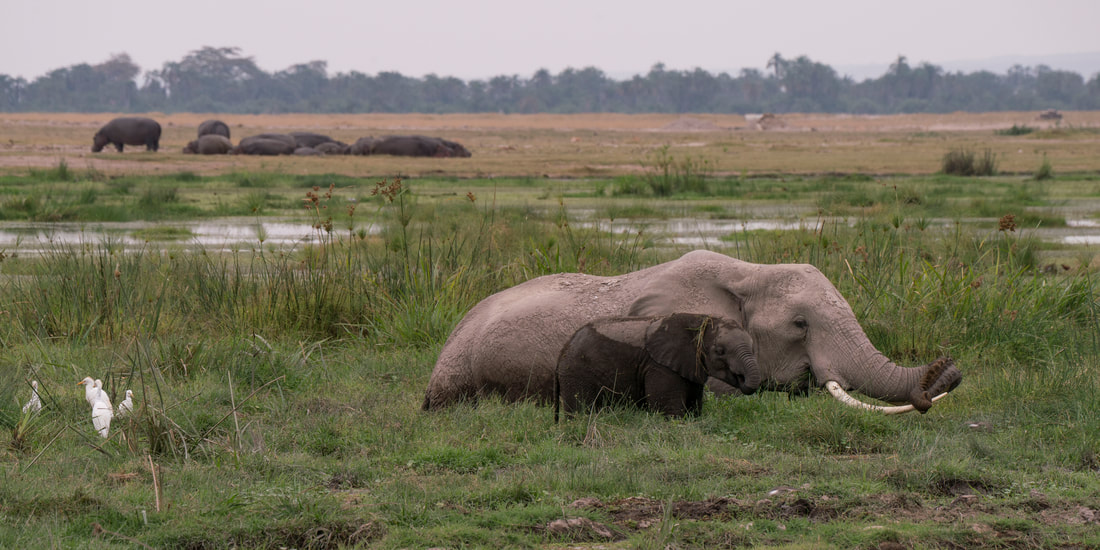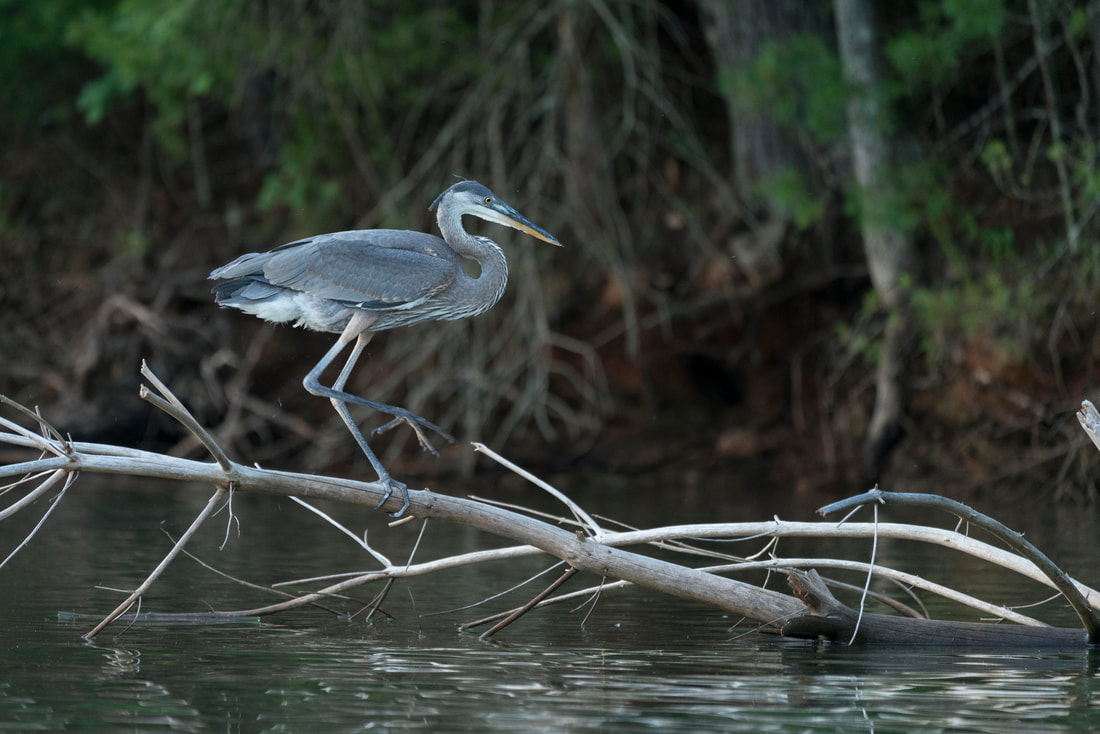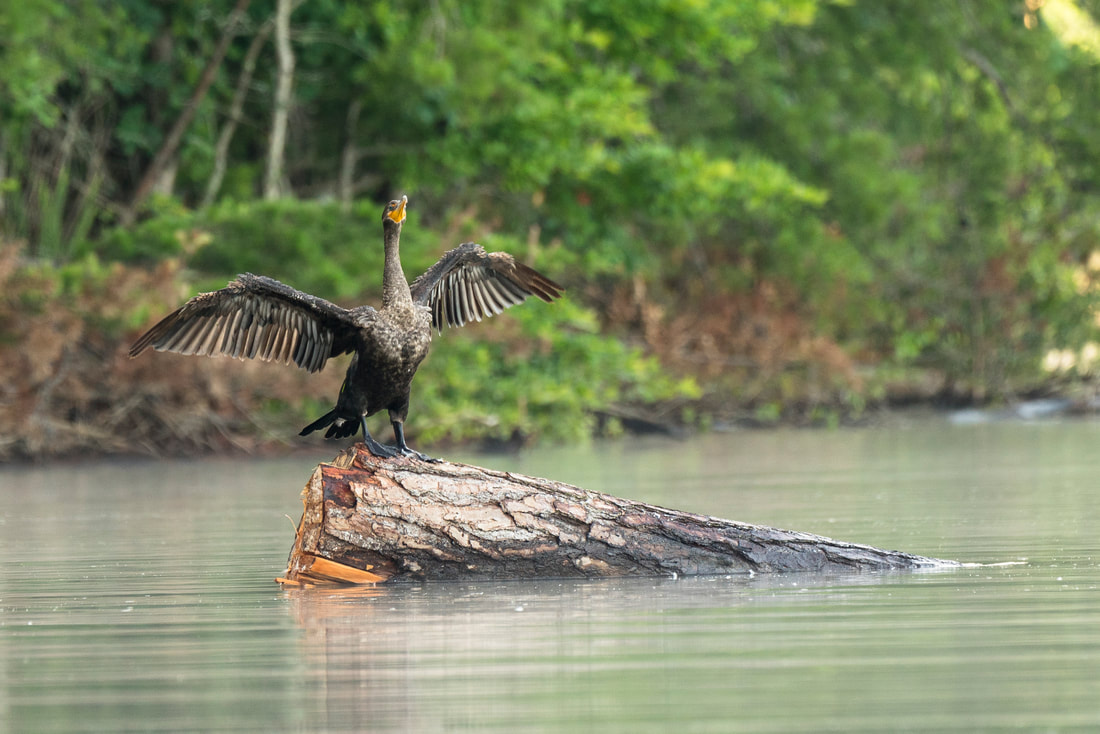|
I am working on a travel book about African safaris and will be posting a few more entries to our Safari Series as a consequence. For now, here's our encounter with the hippopotami. THE HIPPOPOTAMUS IS one of Africa’s most feared animals. Weighing in at close to 3,000 pounds, it has an aggressive and unpredictable temperament. They are also, despite their weight and short legs, able to run at speeds up to 19 miles per hour over short distances. For us, however, they had been an elusive background creature with our only sightings being from a distance around the marshes in Amboseli National Park. So, we were excited when we learned, on our arrival, that a pod of hippos lived in the river just behind Lion Camp. Unfortunately, our raised expectations went unfulfilled for the first couple of days. Then our proximity was confirmed on an after-dinner game drive when our spotter’s searchlight found several grazing in the grass not far from camp. (Safari Series: African Night.) We stayed a respectful distance away. They are at their most unpredictable and dangerous when they are out of the water. A good way to get trampled is to get between them and the water. On our third day in camp, we stopped mid-morning above a river for breakfast. The embankment on our side was steep, more than eight feet, and sheer, falling straight down to the river. Upstream, the river widened, and the embankments were more modest. Standing on shore there were two hippos grazing in the grass. We could hear the rest of the pod in the water beneath our picnic spot before we could see them. As we set up breakfast, we would hear their snorts as the came to the surface and exhaled. To see the pod, we had to walk close to the edge of the embankment and look down. There in the water were more than a dozen hippos gathered loosely together. Further downstream an enormous crocodile was napping on shore. Some of the hippos were wading with their heads just above the surface - eyes, ears and nostrils visible but nothing else. Others were underwater until they surfaced and exhaled through their noses. For some quirky reason, the sight brought back to mind an old novelty Christmas song from 1953 about a girl who wants a hippopotamus. Performed by Gayla Peevey, the lyrics included this stanza: I want a hippopotamus for Christmas Only a hippopotamus will do No crocodiles, no rhinoceroses I only likes hippopotamuses And hippopotamuses like me, too But then this moment was quickly dashed. Our spotter walked to the edge of the embankment and kicked a clod of dirt down to the river. The resulting splash woke the hippos from their drowsy repose and set them in a rage. All eyes turned to the disturbance and we could feel their aggression as they rushed at the embankment. This is not part of the aggression. It occurred later and is just a yawn by one of the bigger hippos. For a mostly herbivorous creature, those are some serious incisors. The stare below is what we received for several minutes after we rudely interrupted their peaceful river. You might think of the hippopotamus as the Rodney Dangerfield of Africa’s big animals. Rodney was an American comedian who made a living telling jokes about how he never got respect. Hippos could claim that disrespect as well. Despite their size and ferocity, the hippo fails to make the short list, or Big 5, of African game. That honor is reserved for the elephant, cape buffalo, rhinoceros, lion and leopard. After their reaction to the dirt clod, I would vote to expand the Big 5 to a Big 6 and let the hippo in. After our breakfast, we left the hippos and headed on. What I remembered most were their red eyes peering in our direction. I was glad for the experience and for having an steep embankment next to our picnic site. ---
All photos and text are copyright Clinton Richardson. The images are from the author's Safari Collection at Trekpic.com. If you like these posts, please tell your friends about the Venture Moola blog at Readjanus.com. Want to plan your own safari? If so, feel free to check out the outfitter we used at Porini.com. And, feel free to share this blog. The more readers the better. Click here if you would like to get a weekly email that notifies you when we release new entries. Or, click in the side column to follow us on Facebook or Twitter. We won't answer that question here but watching the youngest Richardson consume a waffle this morning reminded me of an earlier experience with his older cousin. The youngest eats his waffles with his fingers and then wipes his sticky fingers in his curly blond hair. His older cousin, you will see, has a much more refined technique. How to Eat a Waffle. (Don’t try this at home!) Receive and inspect waffle. Play with eggs while waiting for syrup. Grab sticky syrup dispenser with both hands. Pour liberally on waffle, first up and down the creases that separate the four parts of the waffle and then over waffled portion. Look at sticky hands. Inspect waffle. Take knife and cut the four creases to create four waffle quarters. Take same knife and cut one quarter into long strips. Work knife under strip to raise waffle toward mouth. At the same time, lower chin almost to the chest and turn head to the right. Carefully raise knife toward mouth and slip waffle toward mouth without sticking knife in mouth. Fill mouth with waffle, lift-up head and chew. While chewing, declare waffle to be good. Slip closer to table and repeat. Skip declaration. Drink chocolate milk slowly. Smile. Wipe sticky hands on shirt and think better of it. Reach for napkin and wipe hands. Finish milk and walk to bathroom to wash hands, face and elbows. Apply soap liberally, wash and dry gently with paper towels. Be careful not to remove freckles. Walk to car, buckle seat belt and head to Mine Craft camp. Convince Papa to turn on the navigation system and take detour from designated route. Practice saying “route recalculation” in your best robot voice. Discuss other potential detours. Arrive at camp and depart. -----
All photos and text are copyright Clinton Richardson. This image is from Springfield, Illinois, just outside the courthouse where Abe Lincoln practiced law. The photo was taken late one Spring night in 2017. If you like these posts, please tell your friends about the Venture Moola blog at Readjanus.com. For more photos, check out at Trekpic.com. Feel free to share this blog. The more readers the better. Click here if you would like to get a weekly email that notifies you when we release new entries. Or, click in the side column to follow us on Facebook or Twitter. You may remember our posts from last year about coming to the realization that we had a colony of great blue herons nesting nearby - Dinosaurs Across the Cove, May 31, 2018 and Seeing Through a Lens, June 28, 2018 - where we discovered that the racket we were hearing across the cover was not the result of a single nest of herons. Instead, over the course of a week's observation from a kayak drifting along the edge of the water, we found a dozen active nests. This young heron was practicing the new-to-her art of fishing just below her nest one of those mornings and allowed me to drift close enough to capture this image. Well, they are back in full force. The colony continues to thrive. Outings in May and June this year spotted nine active nests along the shoreline with more obvious activity just out-of-site behind the tree line. Sometimes you can hear them when you cannot see them. In my first outing this year, I was greeted by a young heron in the same location as the photo above and, not 30 feet away, a cormorant just like the one below sitting on this same log. It was a perfect welcome back moment. (See The Launch, July 12, 2918). Both sat quietly as my kayak drifted closer. A repeat from last year when I found both spots similarly occupied on the same morning. It was a "deja vu all over again" moment as Yogi Berra would have said. Except this year there was a difference. As I looked toward the shore behind the heron, an adult heron walked out to join it's charge. A fishing lesson was in process. Here is wishing you a great 4th of July week. Enjoy a heron audio clip from Audubon.org. Worth a short listen. My imagination tells me these calls include much of what we might have heard during the Cretaceous Period if we could get close to the heron's ancestors - other colony sounds. Let me know if you do not think they sound somewhat other worldly. -----
All photos and text are copyright Clinton Richardson. If you like these posts, please tell your friends about the Venture Moola blog at Readjanus.com. For more photos, check out at Trekpic.com. Feel free to share this blog. The more readers the better. Click here if you would like to get a weekly email that notifies you when we release new entries. Or, click in the side column to follow us on Facebook or Twitter. |
the blog
Travel, history, and business with original photos.
your hostClinton Richardson - author, photographer, business advisor, traveler. Categories
All
Archives
July 2023
Follow us on Facebook
|
Check out Ancient Selfies a 2017 International Book Awards Finalist in History and 2018 eLit Awards Gold Medal Winner and
Passports in his Underpants - A Planet Friendly Photo Safari a 2020 Readers' Favorite Winner in Nonfiction
Site Copyright 2024 by Clinton Richardson







 RSS Feed
RSS Feed